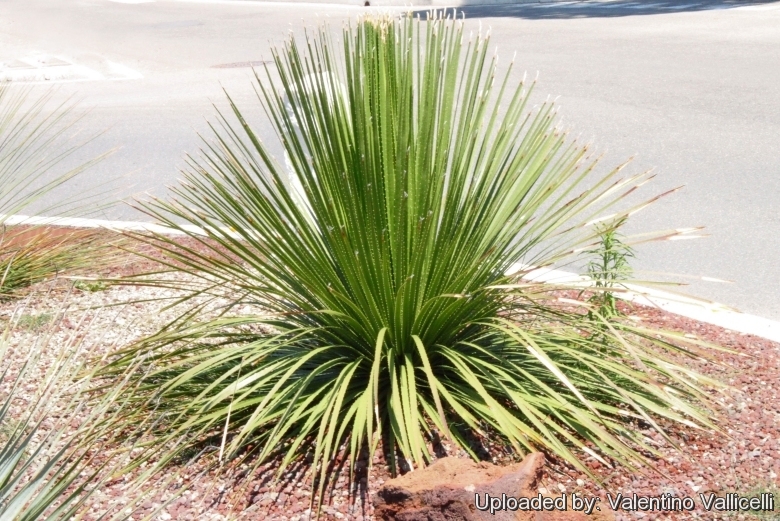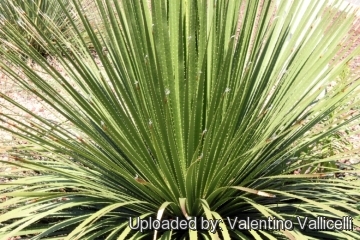Accepted Scientific Name: Dasylirion serratifolium (Karw. ex Schult. & Schult.f.) Zucc.
Allg. Gartenzeitung (Otto & Dietrich) 6: 258 1838 Otto & A.Dietr.

Yucca serratifolia (Dasylirion serratifolium) Photo by: Valentino Vallicelli
Photo taken at Cervia, Adriatic coast of Emilia Romagna, Italy.
Origin and Habitat: Southeastern Mexico. Hidalgo and Oaxaca. It is often cultivation as an ornamental in other places, including in Europe.
Altitude ranges: 1800-2350 metres above sea level.
Habitat: It grows in arid regions in rocky slopes and in shrubby woodland associated with Yucca periculosaSN|29988]]SN|29988]], Agave salmianaSN|27883]]SN|27883]] and Nolina longifoliaSN|33535]]SN|33535]].
Synonyms:
See all synonyms of Dasylirion serratifolium
back
Accepted name in llifle Database:Dasylirion serratifolium (Karw. ex Schult. & Schult.f.) Zucc.Allg. Gartenzeitung (Otto & Dietrich) 6: 258 1838Synonymy: 4
back
Common Names include:
ENGLISH: Sandpaper Sotol, Desert Spoon
SPANISH (Español): Maguey Cucharita, Sotol
Description: Dasylirion serratifoliumSN|22721]]SN|27879]] is a subacaulescent Yucca-like plant that forms dens hemispherical rosettes of leaves up to 100-200 cm in height and diameter. These rosettes are perfectly symmetrical. The leaves are narrow, prominently serrate, and armed with flexible prickles. The tips of which are fanned out to wide brushes.
Trunk: Very short and stocky, large, solitary or sometimes branched at the base, woody, felted with old leaves. It develops only after several years when mature.
Leaves: 60-100 cm long, 15-20 or even 35 mm wide, scarcely metre long, whitish, finely roughened on one or both faces, grey-green, dull green to glaucous, rough. Margins serrated hooked, deep yellow spines, directed upwards, 1-3 mm long, irregularly arranged 5-10 or even 20 mm Apart. Apex fibrous juast at the juvenile stage.
Inflorescence (Panicle): Stalk woody 2-4 m high, inflorescence ample, loose, narrow, red to purple.
Flowers: Small very numerous, spaced, cream-coloured. Perianth c. 2 mm.
Fruit: Quadrately round-obovate, broadly winged, 6-8 mm long and 4-5(-8) mm wide, the style equaling the narrow rather deep notch. The capsules contain a single seed.
Blooming season: Summer (In habitat the flowering period extends from June to July)
Seed: Triangular 3-4 mm long and 2-4 mm wide.
Similar species: It is similar to the more northern occurring Dasylirion lucidum, but differences in flower and leaf structure are evident. This plant is also similar to Dasylirion wheeleriSN|27879]]SN|22721]] except the terminus of the leaf blade is bent over; whereas that of wheeleri curls.
Note: In cultivation the name D. serratifolium is commonly used for a mixed group of hybrids that have green leaves with toothed margins and terminal tufts.
Bibliography: Major references and further lectures
1) Urs EggliI “llustrated Handbook of Succulent Plants: Monocotyledons: Monocotyledons” Springer, 17/Jul/2001
2) James Cullen, Sabina G. Knees, H. Suzanne Cubey “The European Garden Flora Flowering Plants: A Manual for the Identification of Plants Cultivated in Europe, Both Out-of-Doors and Under Glass” Cambridge University Press, 11/Aug/2011
3) “Proceedings, American Philosophical Society” American Philosophical Society vol. 50, 1911
4) Report of the Missouri Botanical Garden 14: t. 12 1903
5) Zuccarini in: Allg. Gartenzeitung (Otto & Dietrich) 6: 258. 1838, nomen; et in Abh. Akad. Muench. 3: 225. 1843
6) CONABIO. “Catálogo taxonómico de especies de México.” 1. In Ca. nat. México. CONABIO, Mexico City. 2009.
7) Fritz Hochstätter “The Genus Dasylirion. (Nolinaceae) part 2.” In: Piante Grasse. 31:3, 119–120. 2011
8) Bogler, D. J. “Systematics of Dasylirion: taxonomy and molecular phylogeny.” Bol. Soc. Bot. México 56: 69–76 1995
9) LÓPEZ GONZÁLEZ, Ginés A. "Los árboles y arbustos de la Península Ibérica e Islas Baleares." (2 vol.) Madrid: Mundi-Prensa, 2001
10) THE ROYAL HORTICULTURAL SOCIETY. "Enciclopedia de plantas y flores." Barcelona: Grijalbo, 1996
 Yucca serratifolia (Dasylirion serratifolium) Photo by: Valentino Vallicelli
Yucca serratifolia (Dasylirion serratifolium) Photo by: Valentino Vallicelli Photo taken at Cervia, Adriatic coast of Emilia Romagna, Italy. (Dasylirion serratifolium) Photo by: Valentino Vallicelli
Photo taken at Cervia, Adriatic coast of Emilia Romagna, Italy. (Dasylirion serratifolium) Photo by: Valentino VallicelliCultivation and Propagation: The Sandpaper sotols Dasylirion longissimumSN|21896]]SN|21896]] are slow growing, carefree and durable plant. This species is highly tolerant of drought and heat. It is equal in many respects to the commonly used Yucca filamentosaSN|30078]]SN|30078]] except that it does not possess quite the same degree of hardiness.
Waterings: Provide little or no water in winter. Treat like a succulent. However, they grow faster if watered well (don't water the crown, though they rot easily). In the garden they should be placed in a sunny, well-drained area with additional summer water in dry climates.
Exposure: They thrive best in full sun, but can be grown with some shade and humidity, but may become leggy.
Uses: These make great specimen plants for xeriscape gardens and blend well in either tropical or arid gardens with Yucca, Nolina, Agave and Chamaerops. Small plants are relatively inexpensive, but larger ones are a fortune. These make excellent potted specimens, and their symmetrical form provides a striking focal point, ans display wonderful shadows when illuminated by night lighting.
Traditional uses: Leaves of this plant are used in popular culture to make baskets, hats and strings. Sandpaper sotol and some other plants from the same family are used in making a liqueur called Sotol.
Soil: Plant in very fast draining soil. It is adapted to a hot, dry environment, but has some tolerance to moisture and humidity when planted in a very well-draining soil.
Hardiness. Best where winter temperatures stay above 10° C, but can take some periods of frost (cold hardy to at least -10 ° C). Plants in containers can be taken under glass for winter.
Maintenance: When the trunk is pruned of the older, lower leaves, the remaining leaf bases create a beautiful symmetrical spiral leaf-base pattern.
Propagation: Easy to propagate from seeds or cuttings (If available).












